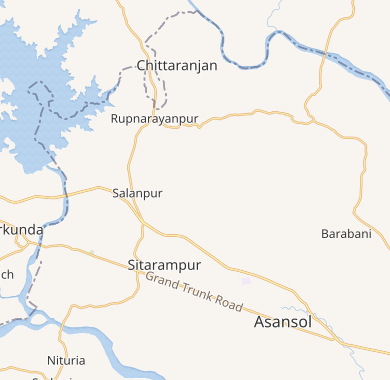Barakar: Difference between revisions
Restored revision 1008639550 by ClueBot NG (talk): Rv |
Bishal tiwari Tags: Reverted Mobile edit Mobile web edit |
||
| Line 1: | Line 1: | ||
{{Use dmy dates|date= |
Bishal tiwari 123 instagram pe follow kar{{Use dmy dates|date=May2018}} |
||
{{Use Indian English|date=August 2017}} |
{{Use Indian English|date=August 2017}} |
||
Revision as of 16:32, 29 November 2021
Bishal tiwari 123 instagram pe follow kar
Barakar | |
|---|---|
Neighbourhood in Asansol | |
 Barakar River at Barakar | |
| Coordinates: 23°44′N 86°51′E / 23.73°N 86.85°E | |
| Country | |
| State | West Bengal |
| District | Paschim Bardhaman |
| City | Asansol |
| Municipal Corporation | Asansol Municipal Corporation |
| AMC wards | Ward Nos. 66,67,68,69 |
| Languages* | |
| • Official | Bengali, Hindi, English |
| Time zone | UTC+5:30 (IST) |
| Lok Sabha constituency | Asansol |
| Vidhan Sabha constituency | Kulti |
| Website | paschimbardhaman |
Barakar is a neighbourhood in Asansol in the Paschim Bardhaman district in the Indian state of West Bengal. It is governed by the Asansol Municipal Corporation[1]It is situated at the border of the states of Jharkhand and West Bengal. The Grand Trunk Road passes through Barakar. The neighbourhood is located on the banks of the river Barakar.
Geography

3miles
Reservoir
Locomotive
Works
Steel Plant
Area Office
Area Office
Temple
MC: municipal corporation, P: rural administrative centre, CT: census town, N: neighbourhood, OG: out growth, T: temple
Owing to space constraints in the small map, the actual locations in a larger map may vary slightly
Urbanisation
As per the 2011 census, 83.33% of the population of Asansol Sadar subdivision was urban and 16.67% was rural.[2] Asansol Sadar subdivision has 26 (+1 partly) Census Towns.
Note: The map alongside presents some of the notable locations in the subdivision. All places marked in the map are linked in the larger full screen map.
.
Asansol Municipal Corporation
According to the Kolkata Gazette notification of 3 June 2015, the municipal areas of Kulti, Raniganj and Jamuria were included within the jurisdiction of Asansol Municipal Corporation.[3]
*For language details see Salanpur (community development block)#Language and religion
Begunia temples
The area is known for its Siddheshvara Temple, an early (9C) Hindu religious structure of the Orissan style with a prominent shikhara. It later served as inspiration for other temples, devoted to Ganesh, Durga and Panchanana, built in the 16C.[4]
There are four temples in one complex known as Begunia temples. The fourth temple, last from the entrance, seems to be the oldest and was built around 8th-9th century. It is amongst the oldest rekh-deul temples in West Bengal. Two other temples are dated around 14th-15th century. The temples have Shiva lingams and idols of Ganesha and Durga. Many stone idols have been discovered in the complex. Some are Vishnu idols but others are Jain idols, possibly belonging to the older fourth temple. It is evident that Barakar was once a Buddhist and Jain religious centre. Thereafter, it became a Shaivite centre and was also a Vaishnavite centre at some point of time.[5]
Barakar picture gallery
-
Front view of Ganesh and Durga temples, photographed by JD Beglar in 1872
-
Panchanana temple, photographed around 1872
-
Siddheswara temple, photographed by JD Beglar in 1872
-
Hanuman Mandir, Barakar
References
- ^ "Archived copy" (PDF). Archived from the original (PDF) on 12 March 2017. Retrieved 9 March 2017.
{{cite web}}: CS1 maint: archived copy as title (link) - ^ "District Statistical Handbook 2014 Burdwan". Table 2.2, 2.4(a). Department of Statistics and Programme Implementation, Government of West Bengal. Archived from the original on 21 January 2019. Retrieved 4 September 2018.
- ^ "The Kolkata Gazette" (PDF). Notification No. 335/MA/O/C-4/1M-36/2014 dated 3 June 2015. Department of Municipal Affairs, Government of West Bengal. Archived from the original (PDF) on 12 March 2017. Retrieved 9 March 2017.
- ^ G. Mitchell (1989). The Monuments of India, vol. I, p. 218. New York: Viking Penguin.
- ^ Ghosh, Binoy, Paschim Banger Sanskriti, (in Bengali), part I, 1976 edition, pp. 219-221, Prakash Bhaban







